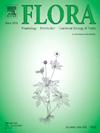Implication of morphological and molecular studies on taxonomic treatment of Acer L. spp. and some selected taxa of Sapindaceae Juss. s.l.
IF 1.7
4区 生物学
Q3 ECOLOGY
引用次数: 0
Abstract
The concept of Sapindaceae has a great conflict among different classification systems, due to the close relationship with Aceraceae. Many recent studies nested the Acer within Sapindaceae based on morphological and molecular criteria. This study aims to assess the potentiality of macro-, micro-morphological as well as molecular criteria (ScoT analysis) for clarifying the taxonomic position of the two Acer species in relation to Sapindaceae s.s.. Acer oblongum & A. negundo in addition to 12 taxa of Sapindaceae were collected to investigate the morphological and anatomical characteristics of stem, petiole & lamina as well as the genetic diversity based on SCoT polymorphism. These data were numerically analyzed using UPGMA clustering methods. The habit, leaf composition, laticifers, and vascular supply specially of petiole and mesophyll types were considered diagnostic at generic and specific levels and support the alliance between the two Acer species and the remaining taxa of Sapindaceae. The resulting dendrogram from the combined anatomical and molecular data showed that; the two Acer species are closely related to the remaining studied taxa. This result encourages the placement of Acer in a distinct subfamily within Sapindaceae.
求助全文
约1分钟内获得全文
求助全文
来源期刊

Flora
生物-植物科学
CiteScore
3.30
自引率
10.50%
发文量
130
审稿时长
54 days
期刊介绍:
FLORA publishes original contributions and review articles on plant structure (morphology and anatomy), plant distribution (incl. phylogeography) and plant functional ecology (ecophysiology, population ecology and population genetics, organismic interactions, community ecology, ecosystem ecology). Manuscripts (both original and review articles) on a single topic can be compiled in Special Issues, for which suggestions are welcome.
FLORA, the scientific botanical journal with the longest uninterrupted publication sequence (since 1818), considers manuscripts in the above areas which appeal a broad scientific and international readership. Manuscripts focused on floristics and vegetation science will only be considered if they exceed the pure descriptive approach and have relevance for interpreting plant morphology, distribution or ecology. Manuscripts whose content is restricted to purely systematic and nomenclature matters, to geobotanical aspects of only local interest, to pure applications in agri-, horti- or silviculture and pharmacology, and experimental studies dealing exclusively with investigations at the cellular and subcellular level will not be accepted. Manuscripts dealing with comparative and evolutionary aspects of morphology, anatomy and development are welcome.
 求助内容:
求助内容: 应助结果提醒方式:
应助结果提醒方式:


